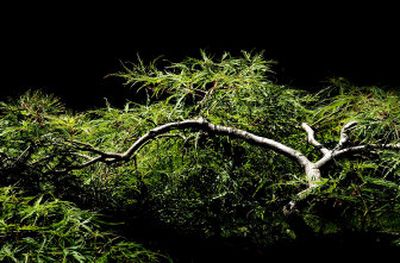Dave Daniel’s destiny is Japanese trees

Dave Daniel’s fascination with Japanese maples began when he was a boy watching the construction of the Nishinomiya Japanese Garden at Manito Park right across the street from his house. As he watched the maples being planted in the garden, he knew that some day he would have to grow one for himself.
More than 30 years later, Daniel has dozens of them planted in his shady backyard in Spokane Valley, and more for sale through his Wabi Sabi Japanese Gardens.
Daniel’s passion is obvious. Strolling through his Japanese-style garden he rattles off the Japanese variety names and the characteristics of his trees while gently touching each one as we pass them. “It is an honor to go back in my own garden,” he says. “There is something about the quiet solitude that you get out a Japanese garden because it isn’t loud. The different varieties of green have a calming nature to them that makes it unlike any other garden.”
While there are hundreds of named varieties of Japanese maple, they can all be broken into roughly six classes. The smallest, the dwarf variety, stay under 6 feet while the semidwarf, slow growing trees can reach 12 to 15 feet tall. The uprights can grow from 15 feet with a few varieties reaching 30 feet. The variegated varieties display a wide range of colors from subtle shifts in greens to spectacular combinations of green, pink, while and yellow. The disectum or laceleaf and the linearilobum or threadleaf maples are characterized by very finely dissected leaves. The laceleaf, one of the best known forms of the tree, has finely serrated leaf margins while the thread leaf has smooth edges and has been likened to bamboo leaves. The trees in all these classes come in both red- and green-leaved forms.
Japanese maples are four-season trees. In the spring, new foliage, depending on the variety, appears in shades of red, yellow or cream, and then ages through spring and into summer to green or red. In the summer, the thin leaves catch light creating wonderful color patterns in the garden. In the fall, the Japanese maples turn fiery shades of red, orange and yellow again catching the low autumn light.
With the coming of winter, its graceful branch structure and the reddish or yellow bark of some varieties creates winter interest in the garden.
Japanese maples have only a few key growing requirements and if those can be met, the tree has a long life span. “A constant moisture (level) is really what they like the best,” says Daniel. “You don’t want it too wet or too dry. If they dry out, they’re toast.”
The maples prefer a well-drained soil of average fertility like a sandy loam says Daniel. If you have clay, he recommends digging a deeper hole and putting in a drain or a layer of gravel.
While a few, like “Bloodgood” can handle the Inland Northwest sun, most (especially the variegated varieties) prefer some shade. “Filtered sun is always going to be best for any of the Japanese maples,” says Daniel. “That’s why they work so well among the pines.”
Japanese maples have few problems with disease or insects. They don’t need much if any fertilizer. Their roots grow well with other plants making it possible to plant under their canopy. Because they tend to leaf out fairly early in the spring, the tender new foliage can be damaged by frost but the tree usually sends out another set of leaves to compensate.
Pruning is the key to getting the best out of your tree, said Daniel. He prunes heavily in early spring and shapes his trees through the summer.